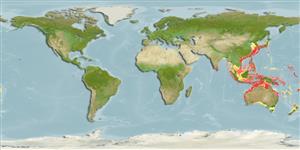Common names from other countries
Environment: milieu / climate zone / depth range / distribution range
Ecologia
marinhas demersal; intervalo de profundidade 20 - 200 m (Ref. 54393), usually 74 - 78 m (Ref. 54393). Tropical
Indo-West Pacific: disjunct distribution: Japan to coast of Aomori Prefecture, Honshu, the Izu Peninsula, Kochi Pref., Ogasawara Islands and southeastern Taiwan; in the south from the Arafura Sea, the NW shelf and Kimberly region of Western Australia; from Geographe Bay northwards.
Tamanho / Peso / Idade
Maturity: Lm ? range ? - ? cm
Max length : 55.0 cm TL macho/indeterminado; (Ref. 48636)
Espinhos dorsais (total): 8; Raios dorsais (total): 9; Espinhos anais 1; Raios anais : 7. This species is distinguished by the following characters: pectoral rays 15-16 (rarely 15); gill rakers 6-7 + 19-22 = 26-28; greatest body depth at or slightly anterior to origin of dorsal fin, 2.9-3.25 in SL; head length (HL) 2.8-3.1 in SL; snout length 1.65-1.9 in HL; cheek depth (lower edge of eye vertically to ventral margin of preopercle) 6.5-9.6 in SL; barbels 1.35-1.45 in HL; the longest dorsal spine 1.5-1.75 in HL; pectoral-fin length 1.25-1.4 in HL, 3.55-4.2 in SL; pelvic-fin length 1.4-1.65 in HL. Colour pale reddish to bluish gray, scale edges red, a yellow stripe from eye to base of caudal fin just above lateral line (stripe may be red in fish from deep water); barbels white to pale yellow (Ref. 54393).
Apparently occurs in deeper waters in the warmer seas of lower latitudes (Ref. 54393). Inhabits silt or mud bottoms near reefs (Ref. 90102).Done
Ciclo de vida ou comportamento de acasalamento
Maturidade | Reprodução | Desova | Ovos | Fecundidade | Larvas
Randall, J.E., 2004. Revision of the goatfish genus Parupeneus (Perciformes: Mullidae), with descriptions of two new species. Indo-Pac. Fish. (36):64 p. (Ref. 54393)
Status na Lista Vermelha da UICN (Ref. 130435)
CITES (Ref. 128078)
Not Evaluated
Ameaça para os humanos
Harmless
Uso pelos humanos
Mais informação
Nomes comunsSinônimosMetabolismoPredadoresEcotoxicologiaReproduçãoMaturidadeDesovaFecundidadeOvosDesenvolvimento dos ovos
ReferênciasAquaculturaPerfil para aquaculturaEstirpesGenéticaElectrophoresesHereditariedadeDoençasProcessamentoConversão de massa
ColaboradoresFotosStamps, Coins Misc.SonsCiguateraVelocidadeTipo de nataçãoÁrea branquialOtólitosCérebrosVisão
Ferramentas
Relatórios especiais
Baixar XML
Fontes da internet
Estimates based on models
Preferred temperature (Ref.
115969): 18.6 - 27.4, mean 25.9 (based on 42 cells).
Índice de diversidade filogenética (Ref.
82804): PD
50 = 0.5000 [Uniqueness, from 0.5 = low to 2.0 = high].
Bayesian length-weight: a=0.01380 (0.00775 - 0.02460), b=3.08 (2.93 - 3.23), in cm Total Length, based on LWR estimates for this species & Genus-body shape (Ref.
93245).
Nível Trófico (Ref.
69278): 3.5 ±0.37 se; based on food items.
Resiliência (Ref.
120179): médio(a), tempo mínimo de duplicação da população 1,4 - 4,4 anos (Preliminary K or Fecundity.).
Fishing Vulnerability (Ref.
59153): Moderate vulnerability (36 of 100).
